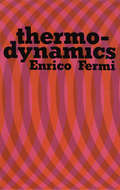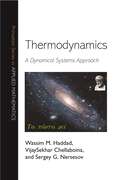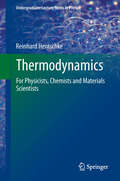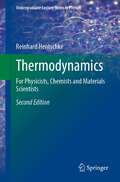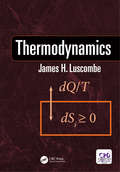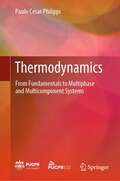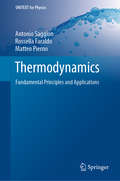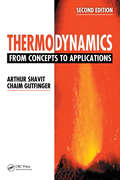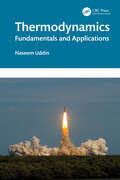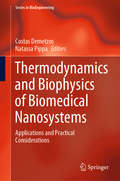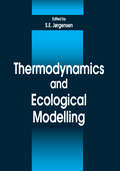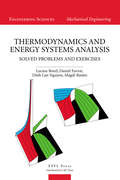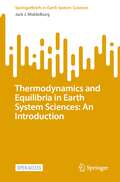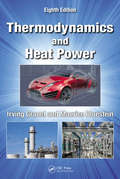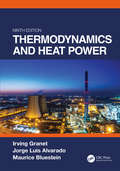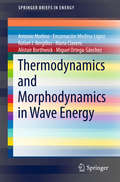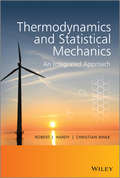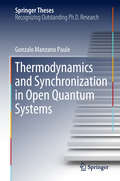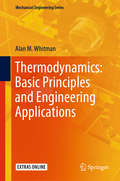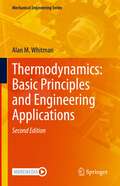- Table View
- List View
Thermodynamics (Dover Books on Physics)
by Enrico FermiIndisputably, this is a modern classic of science. Based on a course of lectures delivered by the author at Columbia University, the text is elementary in treatment and remarkable for its clarity and organization. Although it is assumed that the reader is familiar with the fundamental facts of thermometry and calorimetry, no advanced mathematics beyond calculus is assumed.Partial contents: thermodynamic systems, the first law of thermodynamics (application, adiabatic transformations), the second law of thermodynamics (Carnot cycle, absolute thermodynamic temperature, thermal engines), the entropy (properties of cycles, entropy of a system whose states can be represented on a (V, p) diagram, Clapeyron and Van der Waals equations), thermodynamic potentials (free energy, thermodynamic potential at constant pressure, the phase rule, thermodynamics of the reversible electric cell), gaseous reactions (chemical equilibria in gases, Van't Hoff reaction box, another proof of the equation of gaseous equilibria, principle of Le Chatelier), the thermodynamics of dilute solutions (osmotic pressure, chemical equilibria in solutions, the distribution of a solute between 2 phases vapor pressure, boiling and freezing points), the entropy constant (Nernst's theorem, thermal ionization of a gas, thermionic effect, etc.).
Thermodynamics: A Dynamical Systems Approach (Princeton Series in Applied Mathematics #12)
by Wassim M. Haddad VijaySekhar Chellaboina Sergey G. NersesovThis book places thermodynamics on a system-theoretic foundation so as to harmonize it with classical mechanics. Using the highest standards of exposition and rigor, the authors develop a novel formulation of thermodynamics that can be viewed as a moderate-sized system theory as compared to statistical thermodynamics. This middle-ground theory involves deterministic large-scale dynamical system models that bridge the gap between classical and statistical thermodynamics. The authors' theory is motivated by the fact that a discipline as cardinal as thermodynamics--entrusted with some of the most perplexing secrets of our universe--demands far more than physical mathematics as its underpinning. Even though many great physicists, such as Archimedes, Newton, and Lagrange, have humbled us with their mathematically seamless eurekas over the centuries, this book suggests that a great many physicists and engineers who have developed the theory of thermodynamics seem to have forgotten that mathematics, when used rigorously, is the irrefutable pathway to truth. This book uses system theoretic ideas to bring coherence, clarity, and precision to an extremely important and poorly understood classical area of science.
Thermodynamics
by Reinhard HentschkeThermodynamics is the foundation of many-body physics and thus of physical chemistry and material science as well. Today new sources of useful energy, energy storage, transport and conversion, requiring development of novel technology, are of rapidly increasing importance. This development strongly affects modern industry. Thus, thermodynamics will have to be given more prominence in the science curriculum in colleges and universities - something that is attempted in this book. The structure of this text is simple and transparent, enabling the easy mapping of the text onto a one-semester course syllabus and the attendant study. There are 8 chapters total and one three-part appendix. Throughout the text the student finds numerous examples (solved problems) reaching from cosmic to molecular evolution or from cloud formation to Bose condensation.
Thermodynamics: For Physicists, Chemists and Materials Scientists (Undergraduate Lecture Notes in Physics)
by Reinhard HentschkeConcise, detailed, and transparently structured, this upper-level undergraduate textbook is an excellent resource for a one-semester course on thermodynamics for students majoring in physics, chemistry, or materials science. Throughout the seven chapters and three-part appendix, students benefit from numerous practical examples and solved problems ranging in broad scope from cosmic to molecular evolution; cloud formation to rubber elasticity; and Carnot engines to Monte Carlo simulation of phase equilibria.Lauded in Physics Today as “a valuable resource for students and faculty”, Hentschke’s Thermodynamics presents in this long-anticipated second edition new and extended coverage of a range of topical material, such as thermodynamics of the universe and atmospheric thermodynamics, while also featuring a more application-oriented treatment of surfaces, interfaces, and polymers. Touching on subjects throughout soft-matter physics, superconductors, and complex fluids, this textbook delivers the foundation and breadth of scope necessary to prepare undergraduate students for further study in this timeless yet ever-changing field.
Thermodynamics
by James LuscombeThis book provides an accessible yet thorough introduction to thermodynamics, crafted and class-tested over many years of teaching. Suitable for advanced undergraduate and graduate students, this book delivers clear descriptions of how to think about the mathematics and physics involved. <P><P>The content has been carefully developed in consultation with a large number of instructors, teaching courses worldwide, to ensure wide applicability to modules on thermodynamics. Modern applications of thermodynamics (in physics and related areas) are included throughout—something not offered to the same degree by existing texts in the field.
Thermodynamics
by Gregory Nellis Sanford KleinThis book differs from other thermodynamics texts in its objective which is to provide engineers with the concepts, tools, and experience needed to solve practical real-world energy problems. The presentation integrates computer tools (e.g., EES) with thermodynamic concepts to allow engineering students and practising engineers to solve problems they would otherwise not be able to solve. The use of examples, solved and explained in detail, and supported with property diagrams that are drawn to scale, is ubiquitous in this textbook. The examples are not trivial, drill problems, but rather complex and timely real world problems that are of interest by themselves. As with the presentation, the solutions to these examples are complete and do not skip steps. Similarly the book includes numerous end of chapter problems, both typeset and online. Most of these problems are more detailed than those found in other thermodynamics textbooks. The supplements include complete solutions to all exercises, software downloads, and additional content on selected topics. These are available at the book web site www.cambridge.org/KleinandNellis.
Thermodynamics: From Fundamentals to Multiphase and Multicomponent Systems
by Paulo Cesar PhilippiThis book presents the fundamentals of thermodynamics and is designed to serve as a comprehensive textbook for advanced undergraduate and graduate students. It caters to those who seek a deeper understanding of how irreversibility impacts thermodynamic processes between equilibrium states. Additionally, it aims to provide a thorough grasp of the underlying physical mechanisms governing the macroscopic behavior of multiphase and multicomponent systems, both in equilibrium and non-equilibrium states.
Thermodynamics: Fundamental Principles and Applications (UNITEXT for Physics)
by Antonio Saggion Rossella Faraldo Matteo PiernoThis book offers a comprehensive overview of thermodynamics. It is divided into four parts, the first of which equips readers with a deeper understanding of the fundamental principles of thermodynamics of equilibrium states and of their evolution. The second part applies these principles to a series of generalized situations, presenting applications that are of interest both in their own right and in terms of demonstrating how thermodynamics, as a theory of principle, relates to different fields. In turn, the third part focuses on non-equilibrium configurations and the dynamics of natural processes. It discusses both discontinuous and continuous systems, highlighting the interference among non-equilibrium processes, and the nature of stationary states and of fluctuations in isolated systems. Lastly, part four introduces the relation between physics and information theory, which constitutes a new frontier in fundamental research.The book includes step-by-step exercises, with solutions, to help readers to gain a fuller understanding of the subjects, and also features a series of appendices providing useful mathematical formulae. Reflecting the content of modern university courses on thermodynamics, it is a valuable resource for students and young scientists in the fields of physics, chemistry, and engineering.
Thermodynamics: From Concepts to Applications, Second Edition
by Arthur Shavit Chaim GutfingerThere are many thermodynamics texts on the market, yet most provide a presentation that is at a level too high for those new to the field. This second edition of Thermodynamics continues to provide an accessible introduction to thermodynamics, which maintains an appropriate rigor to prepare newcomers for subsequent, more advanced topics. The book p
Thermodynamics: Concepts and Applications
by Stephen R. TurnsAlthough the focus of this textbook is on traditional thermodynamics topics, the book is concerned with introducing the thermal-fluid sciences as well. It is designed for the instructor to select topics and seamlessly combine them with material from other chapters. Pedagogical devices include: learning objectives, chapter overviews and summaries, historical perspectives, and numerous examples, questions, problems and lavish illustrations. Students are encouraged to use the National Institute of Science and Technology (NIST) online properties database.
Thermodynamics: Fundamentals and Applications
by Naseem UddinThermodynamics: Fundamentals and Applications offers a blend of theory and practical applications for a complete understanding of thermodynamics for various engineering applications. Beginning with a basic introduction and principles of thermodynamics, the book advances to more specialized topics like organic Rankine cycle, gas mixtures, equilibria and chemical reactions.Exploring the first law of thermodynamics, different types of energies and their practical applications in engineering devices, the text covers enthalpy, heat transfer and work interactions with a focus on macroscopic and microscopic perspectives. It introduces the second law of thermodynamics and entropy with an in-depth look at Carnot engines and absolute temperature scales. The book includes applied problems that are solved using COOLPROP, Tilmedia and MAPLE-ThermophysicalData packages.The book is intended for senior undergraduate mechanical, aerospace and chemical engineering students taking courses in thermodynamics.Instructors will be able to utilize a Solutions Manual, Figure Slides, and MAPLE codes for their courses.
Thermodynamics and Biophysics of Biomedical Nanosystems: Applications and Practical Considerations (Series in BioEngineering)
by Costas Demetzos Natassa PippaThis book highlights the recent advances of thermodynamics and biophysics in drug delivery nanosystems and in biomedical nanodevices. The up-to-date book provides an in-depth knowledge of bio-inspired nanotechnological systems for pharmaceutical applications. Biophysics and thermodynamics, supported by mathematics, are the locomotive by which the drug transportation and the targeting processes will be achieved under the light of the modern pharmacotherapy. They are considered as scientific tools that promote the understanding of physicochemical and thermotropic functionality and behavior of artificial cell membranes and structures like nanoparticulate systems. Therefore, this book focusses on new aspects of biophysics and thermodynamics as important elements for evaluating biomedical nanosystems, and it correlates their physicochemical, biophysical and thermodynamical behaviour with those of a living organism.In 2018, Prof. Demetzos was honored with an award by the Order of Sciences of the Academy of Athens for his scientific contribution in Pharmaceutical Nanotechnology.
Thermodynamics and Ecological Modelling (Environmental & Ecological (Math) Modeling)
by Sven E. JorgensenThermodynamics is used increasingly in ecology to understand the system properties of ecosystems because it is a basic science that describes energy transformation from a holistic view. In the last decade, many contributions to ecosystem theory based on thermodynamics have been published, therefore an important step toward integrating these theories and encouraging a more wide spread use of them is to present them in one volume.An ecosystem consists of interdependent living organisms that are also interdependent with their environment, all of which are involved in a constant transfer of energy and mass within a general state of equilibrium or dis-equilibrium. Thermodynamics can quantify exactly how "organized" or "disorganized" a system is - an extremely useful to know when trying to understand how a dynamic ecosystem is behaving.A part of the Environmental and Ecological (Math) Modeling series, Thermodynamics and Ecology is a book-length study - the first of its kind - of the current thinking on how an ecosystem can be explained and predicted in terms of its thermodynamical behavior. After the introductory chapters on the fundamentals of thermodynamics, the book explains how thermodynamic theory can be specifically applied to the "measurement" of an ecosystem, including the assessment of its state of entropy and enthalpy. Additionally, it will show economists how to put these theories to use when trying to quantify the movement of goods and services through another type of complex living system - a human society.
Thermodynamics and Energy Systems Analysis: Volume 2, Solved Problems and Exercises
by Lucien BorelThis book illustrates the basic concepts of phenomenological thermodynamics and how to move from theory to practice by considering problems in the fields of thermodynamics and energy-systems analysis. Many subjects are handled from an energetics or exergetics angle: calorimeters, evaporators, condensers, flow meters, sub or supersonic nozzles, ejec
Thermodynamics and Equilibria in Earth System Sciences: An Introduction (SpringerBriefs in Earth System Sciences)
by Jack J. MiddelburgThermodynamics is needed to understand many processes on Earth, be they physical, chemical, or biological. Thermodynamics is critical to study the atmosphere (lapse rate, fohn winds, circulation), hydrosphere (latent and sensible heat, pressure dependence of freezing/boiling points), geosphere (geothermal gradients, mineral stability) and the biosphere (redox zonation, evolution of biogeochemical cycles). This introduction to thermodynamics and equilibria aims to provide the basic concepts of relevance for atmospheric, marine, climate, and environmental sciences and to prepare students for more advanced classes in physical chemistry, mineralogy, and petrology.This is an open access book.
Thermodynamics and Heat Power
by Irving Granet Maurice BluesteinBuilding on the last edition, (dedicated to exploring alternatives to coal- and oil-based energy conversion methods and published more than ten years ago), Thermodynamics and Heat Power, Eighth Edition updates the status of existing direct energy conversion methods as described in the previous work. Offering a systems approach to the analysis of en
Thermodynamics and Heat Power, Ninth Edition
by Irving Granet Jorge Alvarado Maurice BluesteinThe ninth edition of Thermodynamics and Heat Power contains a revised sequence of thermodynamics concepts including physical properties, processes, and energy systems, to enable the attainment of learning outcomes by Engineering and Engineering Technology students taking an introductory course in thermodynamics. Built around an easily understandable approach, this updated text focuses on thermodynamics fundamentals, and explores renewable energy generation, IC engines, power plants, HVAC, and applied heat transfer. Energy, heat, and work are examined in relation to thermodynamics cycles, and the effects of fluid properties on system performance are explained. Numerous step-by-step examples and problems make this text ideal for undergraduate students. This new edition: Introduces physics-based mathematical formulations and examples in a way that enables problem-solving. Contains extensive learning features within each chapter, and basic computational exercises for in-class and laboratory activities. Includes a straightforward review of applicable calculus concepts. Uses everyday examples to foster a better understanding of thermal science and engineering concepts. This book is suitable for undergraduate students in engineering and engineering technology.
Thermodynamics and Morphodynamics in Wave Energy (SpringerBriefs in Energy)
by Antonio Moñino Encarnación Medina-López Rafael J. Bergillos María Clavero Alistair Borthwick Miguel Ortega-SánchezThis book examines the performance of oscillating water column (OWC) wave energy converters. It discusses the influence of humid air inside the chamber and changes in the seabed, and also investigates the role of wave energy converters in coastal protection. The authors use a real gas model to describe the thermodynamics of the air–water vapour mixture inside the chamber, and the compression and expansion process during the wave cycle. Further, they present an alternative formulation with new perspectives on the adiabatic process of the gaseous phase, including a modified adiabatic index, and subsequent modified thermodynamic state variables such as enthalpy, entropy and specific heat. The book also develops a numerical model using computational fluid dynamics to simulate OWC characteristics in open sea, and studies the performance of a linear turbine using an actuator disk model. It then compares the results from both cases to find an agreement between the analytical and numerical models when humidity is inserted in the gaseous phase. Introducing new concepts to studies of wave energy to provide fresh perspectives on energy extraction and efficiency problems, the book is a valuable resource for researchers and industrial companies involved in thermal energy and coastal engineering. It is also of interest to undergraduate and postgraduate students, as it broadens their view of wave energy.
Thermodynamics and Statistical Mechanics
by Christian Binek Robert J. HardyThis textbook brings together the fundamentals of the macroscopic and microscopic aspects of thermal physics by presenting thermodynamics and statistical mechanics as complementary theories based on small numbers of postulates. The book is designed to give the instructor flexibility in structuring courses for advanced undergraduates and/or beginning graduate students and is written on the principle that a good text should also be a good reference.The presentation of thermodynamics follows the logic of Clausius and Kelvin while relating the concepts involved to familiar phenomena and the modern student's knowledge of the atomic nature of matter. Another unique aspect of the book is the treatment of the mathematics involved. The essential mathematical concepts are briefly reviewed before using them, and the similarity of the mathematics to that employed in other fields of physics is emphasized.The text gives in depth treatments of low density gases, harmonic solids, magnetic and dielectric materials, phase transitions, and the concept of entropy. The microcanonical, canonical, and grand canonical ensembles of statistical mechanics are derived and used as the starting point for the analysis of fluctuations, blackbody radiation, the Maxwell distribution, Fermi-Dirac statistics, Bose-Einstein condensation, and the statistical basis of computer simulations.
Thermodynamics and Statistical Mechanics (Dover Books on Physics)
by Peter T. LandsbergExceptionally articulate treatment combines precise mathematical style with strong physical intuition. Wide range of applications includes negative temperatures, negative heat capacities, special and general relativistic effects, black hole thermodynamics, gravitational collapse, more. Over 100 problems with worked solutions. Advanced undergraduate, graduate level. Table of applications. Useful formulas and other data.
Thermodynamics and Statistical Mechanics
by M. Scott ShellLearn classical thermodynamics alongside statistical mechanics with this fresh approach to the subjects. Molecular and macroscopic principles are explained in an integrated, side-by-side manner to give students a deep, intuitive understanding of thermodynamics and equip them to tackle future research topics that focus on the nanoscale. Entropy is introduced from the get-go, providing a clear explanation of how the classical laws connect to the molecular principles, and closing the gap between the atomic world and thermodynamics. Notation is streamlined throughout, with a focus on general concepts and simple models, for building basic physical intuition and gaining confidence in problem analysis and model development. Well over 400 guided end-of-chapter problems are included, addressing conceptual, fundamental, and applied skill sets. Numerous worked examples are also provided together with handy shaded boxes to emphasize key concepts, making this the complete teaching package for students in chemical engineering and the chemical sciences.
Thermodynamics and Statistical Mechanics of Macromolecular Systems
by Michael BachmannThe structural mechanics of proteins that fold into functional shapes, polymers that aggregate and form clusters, and organic macromolecules that bind to inorganic matter can only be understood through statistical physics and thermodynamics. This book reviews the statistical mechanics concepts and tools necessary for the study of structure formation processes in macromolecular systems that are essentially influenced by finite-size and surface effects. Readers are introduced to molecular modeling approaches, advanced Monte Carlo simulation techniques, and systematic statistical analyses of numerical data. Applications to folding, aggregation, and substrate adsorption processes of polymers and proteins are discussed in great detail. Particular emphasis is placed on the reduction of complexity by coarse-grained modeling, which allows for the efficient, systematic investigation of structural phases and transitions. Providing insight into modern research at this interface between physics, chemistry, biology, and nanotechnology, this book is an excellent reference for graduate students and researchers.
Thermodynamics and Synchronization in Open Quantum Systems (Springer Theses)
by Gonzalo Manzano PauleThis book explores some of the connections between dissipative and quantum effects from a theoretical point of view. It focuses on three main topics: the relation between synchronization and quantum correlations, the thermodynamical properties of fluctuations, and the performance of quantum thermal machines. Dissipation effects have a profound impact on the behavior and properties of quantum systems, and the unavoidable interaction with the surrounding environment, with which systems continuously exchange information, energy, angular momentum and matter, is ultimately responsible for decoherence phenomena and the emergence of classical behavior. However, there is a wide intermediate regime in which the interplay between dissipative and quantum effects gives rise to a plethora of rich and striking phenomena that has just started to be understood. In addition, the recent breakthrough techniques in controlling and manipulating quantum systems in the laboratory have made this phenomenology accessible in experiments and potentially applicable.
Thermodynamics: Basic Principles and Engineering Applications (Mechanical Engineering Series)
by Alan M. WhitmanThis textbook is for a one semester introductory course in thermodynamics, primarily for use in a mechanical or aerospace engineering program, although it could also be used in an engineering science curriculum. The book contains a section on the geometry of curves and surfaces, in order to review those parts of calculus that are needed in thermodynamics for interpolation and in discussing thermodynamic equations of state of simple substances. It presents the First Law of Thermodynamics as an equation for the time rate of change of system energy, the same way that Newton’s Law of Motion, an equation for the time rate of change of system momentum, is presented in Dynamics. Moreover, this emphasis illustrates the importance of the equation to the study of heat transfer and fluid mechanics. New thermodynamic properties, such as internal energy and entropy, are introduced with a motivating discussion rather than by abstract postulation, and connection is made with kinetic theory. Thermodynamic properties of the vaporizable liquids needed for the solution of practical thermodynamic problems (e.g. water and various refrigerants) are presented in a unique tabular format that is both simple to understand and easy to use. All theoretical discussions throughout the book are accompanied by worked examples illustrating their use in practical devices. These examples of the solution of various kinds of thermodynamic problems are all structured in exactly the same way in order to make, as a result of the repetitions, the solution of new problems easier for students to follow, and ultimately, to produce themselves. Many additional problems are provided, half of them with answers, for students to do on their own.
Thermodynamics: Basic Principles and Engineering Applications (Mechanical Engineering Series)
by Alan M. WhitmanThis new edition is designed for a one semester introductory course in thermodynamics, either in mechanical or aerospace engineering, or in an engineering science program. The book contains a section on the geometry of curves and surfaces, in order to review those parts of calculus that are needed in thermodynamics for discussing the thermodynamic equations of state of simple compressible substances, and their approximation by linear interpolation. It presents the First Law of Thermodynamics as an equation for the time rate of change of system energy, the same way that Newton’s Law of Motion, an equation for the time rate of change of system momentum, is presented in Dynamics, and presents the Second Law mathematically as a lower bound for the time rate of change of system entropy. Moreover, this emphasis illustrates the importance of thermodynamics to the study of heat transfer and fluid mechanics. These laws and the associated new thermodynamic properties, energy and entropy, are introduced with extended motivating discussions rather than as abstract postulates, and connections are made with kinetic theory. Thermodynamic properties of the vaporizable liquids- condensible gases needed for the solution of practical thermodynamic problems (e.g. water and a typical refrigerant) are presented in a unique tabular format that is both simple to understand and easy to use. All theoretical discussions throughout the book are accompanied by worked examples illustrating their use in practical devices. These examples of the solution of various kinds of thermodynamic problems are all structured in exactly the same way in order to make, as a result of the repetition, the solution of new problems easier for students to follow, and ultimately, to produce themselves. Many additional problems are provided, half of them with answers, for students to do on their own.
